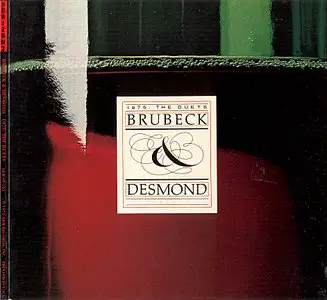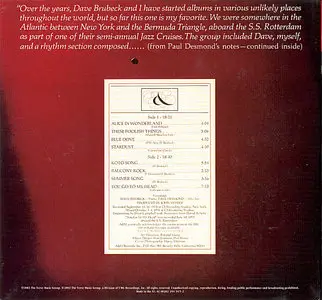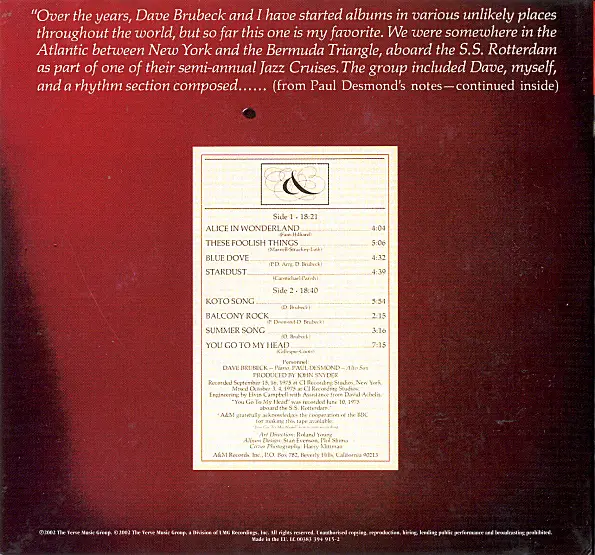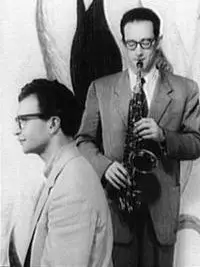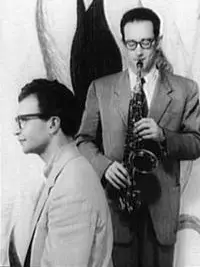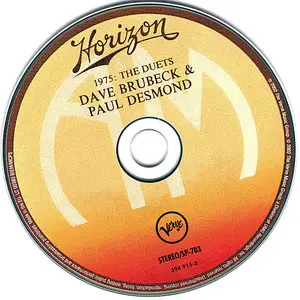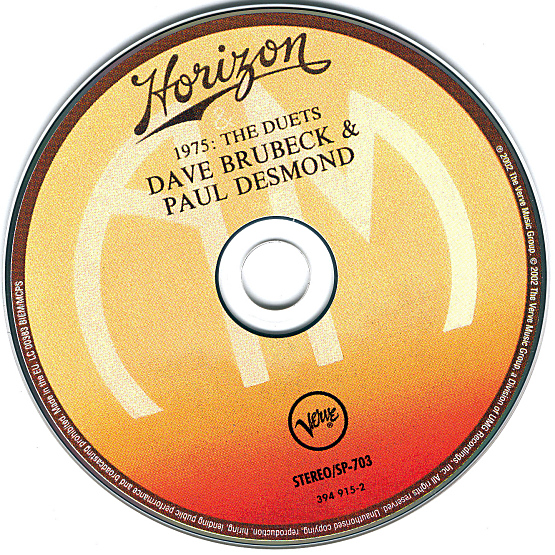Dave Brubeck & Paul Desmond - 1975: The Duets (2002)
Jazz | EAC Rip | APE (image)+CUE+LOG | mp3@320 | 207 MB. & 112 MB.
300dpi. Scans (JPG) included | WinRar, 3% recovery
Audio CD (2002) | Label: Verve/A&M | Catalog# 394-915-2 | 37:38 min.
Jazz | EAC Rip | APE (image)+CUE+LOG | mp3@320 | 207 MB. & 112 MB.
300dpi. Scans (JPG) included | WinRar, 3% recovery
Audio CD (2002) | Label: Verve/A&M | Catalog# 394-915-2 | 37:38 min.
Review by Ken Dryden ~allmusicTracklist:
Although Dave Brubeck and Paul Desmond made many rewarding recordings together, this was their only duo album; it was inspired by several duo performances on board a cruise ship. Their magical ESP is evident from start to finish. Brubeck's lyricism throughout these sessions will surprise critics who label him as "bombastic," while Desmond, known for his pure dry-toned alto sax, throws a few curves to his longtime fans. The loping waltz treatment of "Alice in Wonderland" and a delicate interpretation of the Mexican folk song "The Blue Dove" contrast with their abstract approach to "Stardust." The especially adventurous introduction to Brubeck's oriental blues "Koto Song" opens with Desmond providing percussion by tapping on his instrument's keys without blowing; the piece then slowly evolves from random-sounding fragments into its haunting theme. Their return visit to "Balcony Rock," a collaborative effort from the 1950s, is an absolutely buoyant miniature. Brubeck performs his "Summer Song" alone in a mood of celebration, unlike the wistful flavor of his first recording of it with Louis Armstrong. The audio source for "You Go to My Head" is a BBC videotape made during the concert which inspired the making of this album, but the memorable interaction between the two musicians during this performance should be considered one of the high points of their respective careers. This 2002 CD reissue improves upon the wretched sound of the original LP (caused by use of recycled vinyl) and an earlier CD which omitted Desmond's liner notes and most of the photos. This limited-edition disc is beautifully packaged in a mini-LP gatefold cover with a soft cloth sleeve for the disc. This is an essential acquisition for fans of Dave Brubeck and Paul Desmond.
01. Alice in Wonderland (4:04)
02. These Foolish Things (5:10)
03. Blue Dove (4:35)
04. Stardust (4:45)
05. Koto Song (5:57)
06. Balcony Rock (2:17)
07. Summer Song (3:19)
08. You Go to My Head (7:32)
Personnel:
Dave Brubeck - piano
Paul Desmond - alto saxophone
~allAboutJazz
Born: December 6, 1920 | Instrument: Piano
Brubeck's mother studied piano in England and intended to become a concert pianist; at home she taught piano for extra money. Brubeck was not particularly interested in learning by any particular method, but preferred to create his own melodies, and therefore avoided learning to read sheet music. In college Brubeck was nearly expelled when one of his professors discovered that he could not read sheet music. Several of his professors came forward arguing for his ability with counterpoint and harmony, but the school was still afraid that it would cause a scandal, and only agreed to let Brubeck graduate once he promised never to teach piano. After graduating from the University of the Pacific in 1942, Brubeck was drafted into the army and served overseas in George Patton's Third Army during the Battle of the Bulge. He played in a band, quickly integrating it and gaining both popularity and deference. He returned to college after serving nearly 4 years in the army, this time attending Mills College and studying under Darius Milhaud, who encouraged him to study fugue and orchestration but not classical piano. (Oddly enough, most critics consider Brubeck something of a classical pianist playing jazz.)
After completing his studies under Milhaud, Brubeck signed with Berkeley, California's Fantasy Records. He started an octet including Cal Tjader and Paul Desmond. Highly experimental, the group made few recordings and got even fewer paying jobs. A bit discouraged, Brubeck started a trio with two of the members, not including Desmond, who had a gig of his own, and spent several years playing nothing but jazz standards. Brubeck then formed The Dave Brubeck Quartet in 1951, which consisted of Joe Dodge on drums, Bob Bates on bass, Paul Desmond on saxophone, and of course Brubeck on piano. They took up a long residency at San Francisco's Black Hawk nightclub and gained great popularity touring college campuses, recording a series of albums with such titles as Jazz at Oberlin, Jazz Goes to College and Jazz Goes to Junior College. In 1954 he was featured on the cover of Time Magazine, the first Jazz musician to be so honored. In the mid-1950s Bates and Dodge were respectively replaced by Eugene Wright and Joe Morello. Eugene Wright is African-American; in the late 1950s Brubeck cancelled many concerts because the club owners wanted him to bring a different bassist. He also cancelled a television appearance when he found out that the venue intended to keep Wright off-camera.
In 1959, the Dave Brubeck Quartet released Time Out, an album their label was enthusiastic about but nonetheless hesitant to release. The album contained all original compositions, almost none of which were in common time. Nonetheless, on the strength of these unusual time signatures (the album included “Take Five”, “Blue Rondo à la Turk”, and “Pick Up Sticks”), it quickly went platinum. The quartet followed up its success with several more albums in the same vein, including Time Further Out (1961), Time in Outer Space, and Time Changes. These albums were also known for using contemporary paintings as cover art, featuring the work of Neil Fujita on Time Out, Joan Miró on Time Further Out, Franz Kline on Time in Outer Space, and Sam Francis on Time Changes. A high point for the group was their classic 1963 live album At Carnegie Hall, described by critic Richard Palmer as “arguably Dave Brubeck's greatest concert”.
Apart from the Jazz Goes to College and the 'Time' series, Brubeck recorded several records featuring his compositions based on local music. Jazz Impressions of USA, Jazz Impressions of Japan, Jazz Impressions of Eurasia and Jazz Impressions of New York may not be his most famous works, but all are brilliant examples of the quartet's studio work.
In the early 1960's Dave Brubeck was the program director of WJZZ-FM radio. He achieved his vision of an all jazz format radio station along with his friend and neighbor John E. Metts, one of the first African Americans in senior radio management. From 1956 - 1965 Mr. Metts was the Vice President of an existing news station in Bridgeport, CT, call letters:WICC “Wicc600”. In 1964 WJZZ switched to broadcasting the “Top 100” - most likely due to the British Invasion of Rock and Roll.
The Dave Brubeck Quartet broke up in 1967 except for a 25th anniversary reunion in 1976; Brubeck continued playing with Desmond and then began recording with Gerry Mulligan. Desmond died in 1977 and left everything, including residuals and the immense royalties for “Take Five”, to the American Red Cross. Mulligan and Brubeck recorded together for six years and then Brubeck formed another group with Perry Robinson on clarinet (or Jerry Bergonzi on saxophone), and three of his sons, Dan, Darius, and Chris, on drums, bass, and keyboards. Brubeck continues to write new works, including orchestrations and ballet scores, and tours about 80 cities each year, upto recently about 20 of them in Europe in autumn. From his 85th birthday his European appearances will be limited. His area of focus is the US, where he still premieres new works, like the Cannery Row Suite, and a project with a bigband.
His quartet now includes alto saxophonist and flautist Bobby Militello, bassist Michael Moore (who replaced Alec Dankworth), and his long-time drummer Randy Jones and has recently worked extensively with the London Symphony Orchestra.
Born: December 6, 1920 | Instrument: Piano
Brubeck's mother studied piano in England and intended to become a concert pianist; at home she taught piano for extra money. Brubeck was not particularly interested in learning by any particular method, but preferred to create his own melodies, and therefore avoided learning to read sheet music. In college Brubeck was nearly expelled when one of his professors discovered that he could not read sheet music. Several of his professors came forward arguing for his ability with counterpoint and harmony, but the school was still afraid that it would cause a scandal, and only agreed to let Brubeck graduate once he promised never to teach piano. After graduating from the University of the Pacific in 1942, Brubeck was drafted into the army and served overseas in George Patton's Third Army during the Battle of the Bulge. He played in a band, quickly integrating it and gaining both popularity and deference. He returned to college after serving nearly 4 years in the army, this time attending Mills College and studying under Darius Milhaud, who encouraged him to study fugue and orchestration but not classical piano. (Oddly enough, most critics consider Brubeck something of a classical pianist playing jazz.)
After completing his studies under Milhaud, Brubeck signed with Berkeley, California's Fantasy Records. He started an octet including Cal Tjader and Paul Desmond. Highly experimental, the group made few recordings and got even fewer paying jobs. A bit discouraged, Brubeck started a trio with two of the members, not including Desmond, who had a gig of his own, and spent several years playing nothing but jazz standards. Brubeck then formed The Dave Brubeck Quartet in 1951, which consisted of Joe Dodge on drums, Bob Bates on bass, Paul Desmond on saxophone, and of course Brubeck on piano. They took up a long residency at San Francisco's Black Hawk nightclub and gained great popularity touring college campuses, recording a series of albums with such titles as Jazz at Oberlin, Jazz Goes to College and Jazz Goes to Junior College. In 1954 he was featured on the cover of Time Magazine, the first Jazz musician to be so honored. In the mid-1950s Bates and Dodge were respectively replaced by Eugene Wright and Joe Morello. Eugene Wright is African-American; in the late 1950s Brubeck cancelled many concerts because the club owners wanted him to bring a different bassist. He also cancelled a television appearance when he found out that the venue intended to keep Wright off-camera.
In 1959, the Dave Brubeck Quartet released Time Out, an album their label was enthusiastic about but nonetheless hesitant to release. The album contained all original compositions, almost none of which were in common time. Nonetheless, on the strength of these unusual time signatures (the album included “Take Five”, “Blue Rondo à la Turk”, and “Pick Up Sticks”), it quickly went platinum. The quartet followed up its success with several more albums in the same vein, including Time Further Out (1961), Time in Outer Space, and Time Changes. These albums were also known for using contemporary paintings as cover art, featuring the work of Neil Fujita on Time Out, Joan Miró on Time Further Out, Franz Kline on Time in Outer Space, and Sam Francis on Time Changes. A high point for the group was their classic 1963 live album At Carnegie Hall, described by critic Richard Palmer as “arguably Dave Brubeck's greatest concert”.
Apart from the Jazz Goes to College and the 'Time' series, Brubeck recorded several records featuring his compositions based on local music. Jazz Impressions of USA, Jazz Impressions of Japan, Jazz Impressions of Eurasia and Jazz Impressions of New York may not be his most famous works, but all are brilliant examples of the quartet's studio work.
In the early 1960's Dave Brubeck was the program director of WJZZ-FM radio. He achieved his vision of an all jazz format radio station along with his friend and neighbor John E. Metts, one of the first African Americans in senior radio management. From 1956 - 1965 Mr. Metts was the Vice President of an existing news station in Bridgeport, CT, call letters:WICC “Wicc600”. In 1964 WJZZ switched to broadcasting the “Top 100” - most likely due to the British Invasion of Rock and Roll.
The Dave Brubeck Quartet broke up in 1967 except for a 25th anniversary reunion in 1976; Brubeck continued playing with Desmond and then began recording with Gerry Mulligan. Desmond died in 1977 and left everything, including residuals and the immense royalties for “Take Five”, to the American Red Cross. Mulligan and Brubeck recorded together for six years and then Brubeck formed another group with Perry Robinson on clarinet (or Jerry Bergonzi on saxophone), and three of his sons, Dan, Darius, and Chris, on drums, bass, and keyboards. Brubeck continues to write new works, including orchestrations and ballet scores, and tours about 80 cities each year, upto recently about 20 of them in Europe in autumn. From his 85th birthday his European appearances will be limited. His area of focus is the US, where he still premieres new works, like the Cannery Row Suite, and a project with a bigband.
His quartet now includes alto saxophonist and flautist Bobby Militello, bassist Michael Moore (who replaced Alec Dankworth), and his long-time drummer Randy Jones and has recently worked extensively with the London Symphony Orchestra.
~allAboutJazz
Born: November 25, 1924 | Died: May 30, 1977 | Instrument: Alto Saxophone
He is revered for the pure, gentle tone of his alto saxophone, and the elegant lyricism of his improvisations. For seventeen years he was the lead soloist in the most commercially successful jazz combo ever, the Dave Brubeck Quartet. In an era that worshipped the frenetic, bebop style of Charlie Parker, Paul Desmond found his own sound, a tone that he claimed imitated a “dry martini.” It was a sound that made him a favourite with critics and fans alike, and won him jazz poll after jazz poll. “I have won several prizes as the world's slowest alto player, as well as a special award in 1961 for quietness.” He was a modest, retiring man, known to his friends for his wit and charm. Twenty years after his death from cancer, his music still sells, is still played, and still moves people.
To me his lyricism has never been equalled, as far as logic and lyricism combined, because there's always a strand going back some place in his melodies, and in his choruses that shows a great intellect combined with a great emotionalism, and usually you don't find the two things in one person. - Dave Brubeck
Born in San Francisco in 1924, Desmond was one of the leading proponents of the West Coast “cool” style. Influenced by Lester Young and Pete Brown he originally played clarinet in the big bands of Jack Fina and Alvino Rey. But it was his simpatico partnership with the formally-trained pianist Dave Brubeck that rocketed him to fame on the concert stages of the world. Desmond's melodic solos were in marked contrast to the polytonal rhythms of Brubeck, but somehow they clicked and drove each other to greatness. After meeting and playing together in the late 40s, they formed the Dave Brubeck Quartet in 1951 and never looked back.
For the critics it was a strange musical relationship. Some found Brubeck's playing heavy-handed. In one Down Beat review he was described as “oftimes loud and pounding and seemingly at a loss for melodic ideas.” Desmond meanwhile was gaining a reputation for his “original, intensely personal style.” Famed critic Nat Hentoff called him “one of the most creative figures in modern jazz.” No wonder that articles started appearing questioning the basis of the Desmond-Brubeck collaboration. In 1953, Down Beat proclaimed, “It is again a case where the sideman (in this instance Desmond) seems to be quite superior to the leader as a jazzman.” But through their years together Desmond remained remarkably loyal to his partner, “There's certainly nobody else with whom I would have stuck around this long.” Perhaps it was their uncanny ability to play counterpoint that endeared them to their fans and to each other. Theirs was a musical rapport that Desmond described as “kind of scary.” They toured the world, playing 300 concerts a year, and had a Columbia recording contract that called for four albums a year. In 1959, Desmond penned the first million-seller, jazz single, “Take Five”. It became the theme for the Quartet, de rigueur at all their concert appearances, and it made Desmond a small fortune in royalties.
At the time I really thought it was kind of a throw-away. I was ready to trade the entire rights, lifetime-wise of “Take Five” for a used Ronson electric razor. And the thing that makes “Take Five” work is the bridge, which we almost didn't use. We really came within … I shudder to think how close we came to not using that, because I said “Well I got this theme that we could use for a middle part”. And Dave said, “Well let's run it through.” And that's what made “Take Five”. - Paul Desmond
When the Quartet split up in 1967, Desmond unofficially retired. He was 43 years old, and he didn't play his horn again for three years. Officially he was writing a humorous memoir of his years on the road with the Quartet, to be titled How Many of You Are There in the Quartet? – a question invariably asked by airline stewardesses. The book never appeared. Desmond who had studied creative writing and loved the “concept” of being a writer never got around to it. The closest he came was one hilarious chapter that appeared in the British humour magazine, Punch.
One thing I learned during the years of not playing – I started hanging out in the bar in New York called Elaine's, where a lot of heavyweight writers spend a lot of time, and I discovered over a year or so that almost all of them have secret Walter Mitty dreams of becoming jazz players. And I figure that it's a dumb move to trade a fairly secure place in the world of jazz for Number 493 Unemployed Humorist. - Paul Desmond
Eventually he was coaxed out of retirement to play occasional gigs with his friends. He fronted a quartet featuring guitarist Jim Hall for two weeks at the “Half Note” in New York City, and broke their attendance record. At the New Orleans Jazz Festival he played a soaring set with Gerry Mulligan. As guest soloist he ventured out with the Modern Jazz Quartet for a 1971 Christmas concert. He blew on a couple of albums with his old friend Chet Baker. He appeared with Dave Brubeck in a series of concerts called “Two Generations of Brubeck” in which Dave played with his musical sons, and in 1976, the Quartet reunited for the Silver Anniversary Tour. They were greeted with enthusiasm wherever they played until the deteriorating eyesight of drummer Joe Morello cut short the tour. But his best work of the period was a happy collaboration with three Toronto musicians. Jim Hall talked him into coming to Toronto to play with Canada's premier jazz guitarist Ed Bickert. So thrilled was he with his first two weeks at Toronto's “Bourbon Street”, that Desmond rushed back to New York and talked record producer Creed Taylor into flying Bickert in so that he could record an album with him. Desmond appeared only half a dozen times with his “Canadian Quartet” – Ed Bickert on guitar, Don Thompson on bass, and Jerry Fuller on drums. Fortunately Don Thompson also doubles as a recording engineer, and a number of the club dates were recorded and released. The group also appeared on CBC-TV's Take 30, and were recorded at the Edmonton Jazz Festival.
He was great to play with. He was very easy, because harmonically there was a real clear logic in everything he played musically. The harmony was always right, the melodies were always right. His time was amazing. You don't think of Paul Desmond as a real swinging musician, he's not famous for that. But he had really great time feel, he really did swing beautifully. Playing with him, you really couldn't go wrong. It was really easy to play.” - Don Thompson
At first glance, his seems a small, perhaps insignificant, career. Was he just a minor figure in a jazz landscape of greats? One of the greats, Charlie Parker, named him as his favourite alto player. Julian “Cannonball” Adderley, an arch rival in various jazz polls said, “I believe that Paul Desmond shares with Benny Carter the title of most lyrical altoist. He is a profoundly beautiful player.” Though various critics credited the success of the Dave Brubeck Quartet to Desmond's horn, others over-looked his playing as “too pretty”. Brubeck himself, thought that Desmond lacked ambition, but was upset when he signed a deal with RCA to record on his own, while still part of the Quartet. That RCA deal called for two albums a year and led to an incredible series of recording dates with guitarist Jim Hall, and the Modern Jazz Quartet drummer Connie Kay. Standards such as “I Get a Kick Out of You” and “For All We Know” shared album space with Desmond originals like “Take Ten”, and “El Prince”. They recorded fifty tunes in all, plus an album with strings. There were also two albums with a Desmond/Gerry Mulligan quartet. Then in the 70s he changed labels to CTI, and did half a dozen more albums, proving once again that he was more than just a sideman.
Desmond's pure tone, the ingenuity of his melodic lines, his harmonic resourcefulness, the musical wit that reflected his literate and sophisticated personality, made him one of the most personal and appealing of all jazz stylists. - Doug Ramsey
Though a mild-mannered, professorial-looking man, Desmond was capable of strong emotion. When pushed musically he rose to the occasion, turning out chorus after brilliant chorus. But he was also a moody man. When drummer Joe Morello joined the Quartet in 1956, Desmond disliked his crowd-pleasing performances so much that he threatened to quit the Quartet. Instead, though they shared the same concert stage nearly every night, he didn't speak to Morello for a year. Eventually they became friends, but Desmond could often be found backstage, reading a book during Morello's extended drum solo on “Take Five”. His friends called him “the perennial bachelor” – few knew that he had been married early in life. He had a reputation as a lady's man, and was often seen accompanied by gorgeous models. When pianist Marian McPartland asked him about his dates he punned, “Sometimes they go around with guys who are scuffling – for a while. But usually they end up marrying some cat with a factory. This is the way the world ends, not with a whim but a banker.” Despite his many friends, Gene Lees wrote that Desmond was the “loneliest man” he ever knew. His last concert was with Dave Brubeck in February, 1977 at New York's Avery Fisher Hall. Observers noted that he seemed out of shape, needing 2 or 3 breaths to complete a phrase that he usually did with one great gasp. His many fans didn't know that he was dying, and incapable of the level of playing that he was famous for.
Paul never said it would be the end. But we knew he was getting weaker and weaker. So he just played the second half. And when it came time for the encore, because the whole audience wanted Paul back onstage he said the old cliche “Leave em wanting more.” And we didn't go back on. - Dave Brubeck
In a business where booze and drugs abound, his drinking was legendary, but it was three packs a day that caught up with him in May of that year. Much to his own amusement his liver was fine, “Pristine, one of the great livers of our time. Awash in Dewars and full of health.” He had spoken to Don Thompson earlier that month, making plans to play New York with his quartet, but he never made it. His friends tell of his last weeks, when an old friend, jazz legend Charles Mingus, appeared at his apartment draped in a swirling black cape and a matching Spanish cowboy hat. He stood in silent vigil at Desmond's bedside. Then slowly, Desmond awoke. Looking up, he searched his memory, trying to make sense of the image looming before him. Finally it clicked – the hooded harvester from Ingmar Bergman's The Seventh Seal. “Okay, set up the chess board.” And he grinned.
One of the things I thought about after Paul died was that it was really a shame because he would have been a really great old man. I could see him about 70-75 years old – he would have been terrific just to talk to and hang out with. - Jim Hall
Born: November 25, 1924 | Died: May 30, 1977 | Instrument: Alto Saxophone
He is revered for the pure, gentle tone of his alto saxophone, and the elegant lyricism of his improvisations. For seventeen years he was the lead soloist in the most commercially successful jazz combo ever, the Dave Brubeck Quartet. In an era that worshipped the frenetic, bebop style of Charlie Parker, Paul Desmond found his own sound, a tone that he claimed imitated a “dry martini.” It was a sound that made him a favourite with critics and fans alike, and won him jazz poll after jazz poll. “I have won several prizes as the world's slowest alto player, as well as a special award in 1961 for quietness.” He was a modest, retiring man, known to his friends for his wit and charm. Twenty years after his death from cancer, his music still sells, is still played, and still moves people.
To me his lyricism has never been equalled, as far as logic and lyricism combined, because there's always a strand going back some place in his melodies, and in his choruses that shows a great intellect combined with a great emotionalism, and usually you don't find the two things in one person. - Dave Brubeck
Born in San Francisco in 1924, Desmond was one of the leading proponents of the West Coast “cool” style. Influenced by Lester Young and Pete Brown he originally played clarinet in the big bands of Jack Fina and Alvino Rey. But it was his simpatico partnership with the formally-trained pianist Dave Brubeck that rocketed him to fame on the concert stages of the world. Desmond's melodic solos were in marked contrast to the polytonal rhythms of Brubeck, but somehow they clicked and drove each other to greatness. After meeting and playing together in the late 40s, they formed the Dave Brubeck Quartet in 1951 and never looked back.
For the critics it was a strange musical relationship. Some found Brubeck's playing heavy-handed. In one Down Beat review he was described as “oftimes loud and pounding and seemingly at a loss for melodic ideas.” Desmond meanwhile was gaining a reputation for his “original, intensely personal style.” Famed critic Nat Hentoff called him “one of the most creative figures in modern jazz.” No wonder that articles started appearing questioning the basis of the Desmond-Brubeck collaboration. In 1953, Down Beat proclaimed, “It is again a case where the sideman (in this instance Desmond) seems to be quite superior to the leader as a jazzman.” But through their years together Desmond remained remarkably loyal to his partner, “There's certainly nobody else with whom I would have stuck around this long.” Perhaps it was their uncanny ability to play counterpoint that endeared them to their fans and to each other. Theirs was a musical rapport that Desmond described as “kind of scary.” They toured the world, playing 300 concerts a year, and had a Columbia recording contract that called for four albums a year. In 1959, Desmond penned the first million-seller, jazz single, “Take Five”. It became the theme for the Quartet, de rigueur at all their concert appearances, and it made Desmond a small fortune in royalties.
At the time I really thought it was kind of a throw-away. I was ready to trade the entire rights, lifetime-wise of “Take Five” for a used Ronson electric razor. And the thing that makes “Take Five” work is the bridge, which we almost didn't use. We really came within … I shudder to think how close we came to not using that, because I said “Well I got this theme that we could use for a middle part”. And Dave said, “Well let's run it through.” And that's what made “Take Five”. - Paul Desmond
When the Quartet split up in 1967, Desmond unofficially retired. He was 43 years old, and he didn't play his horn again for three years. Officially he was writing a humorous memoir of his years on the road with the Quartet, to be titled How Many of You Are There in the Quartet? – a question invariably asked by airline stewardesses. The book never appeared. Desmond who had studied creative writing and loved the “concept” of being a writer never got around to it. The closest he came was one hilarious chapter that appeared in the British humour magazine, Punch.
One thing I learned during the years of not playing – I started hanging out in the bar in New York called Elaine's, where a lot of heavyweight writers spend a lot of time, and I discovered over a year or so that almost all of them have secret Walter Mitty dreams of becoming jazz players. And I figure that it's a dumb move to trade a fairly secure place in the world of jazz for Number 493 Unemployed Humorist. - Paul Desmond
Eventually he was coaxed out of retirement to play occasional gigs with his friends. He fronted a quartet featuring guitarist Jim Hall for two weeks at the “Half Note” in New York City, and broke their attendance record. At the New Orleans Jazz Festival he played a soaring set with Gerry Mulligan. As guest soloist he ventured out with the Modern Jazz Quartet for a 1971 Christmas concert. He blew on a couple of albums with his old friend Chet Baker. He appeared with Dave Brubeck in a series of concerts called “Two Generations of Brubeck” in which Dave played with his musical sons, and in 1976, the Quartet reunited for the Silver Anniversary Tour. They were greeted with enthusiasm wherever they played until the deteriorating eyesight of drummer Joe Morello cut short the tour. But his best work of the period was a happy collaboration with three Toronto musicians. Jim Hall talked him into coming to Toronto to play with Canada's premier jazz guitarist Ed Bickert. So thrilled was he with his first two weeks at Toronto's “Bourbon Street”, that Desmond rushed back to New York and talked record producer Creed Taylor into flying Bickert in so that he could record an album with him. Desmond appeared only half a dozen times with his “Canadian Quartet” – Ed Bickert on guitar, Don Thompson on bass, and Jerry Fuller on drums. Fortunately Don Thompson also doubles as a recording engineer, and a number of the club dates were recorded and released. The group also appeared on CBC-TV's Take 30, and were recorded at the Edmonton Jazz Festival.
He was great to play with. He was very easy, because harmonically there was a real clear logic in everything he played musically. The harmony was always right, the melodies were always right. His time was amazing. You don't think of Paul Desmond as a real swinging musician, he's not famous for that. But he had really great time feel, he really did swing beautifully. Playing with him, you really couldn't go wrong. It was really easy to play.” - Don Thompson
At first glance, his seems a small, perhaps insignificant, career. Was he just a minor figure in a jazz landscape of greats? One of the greats, Charlie Parker, named him as his favourite alto player. Julian “Cannonball” Adderley, an arch rival in various jazz polls said, “I believe that Paul Desmond shares with Benny Carter the title of most lyrical altoist. He is a profoundly beautiful player.” Though various critics credited the success of the Dave Brubeck Quartet to Desmond's horn, others over-looked his playing as “too pretty”. Brubeck himself, thought that Desmond lacked ambition, but was upset when he signed a deal with RCA to record on his own, while still part of the Quartet. That RCA deal called for two albums a year and led to an incredible series of recording dates with guitarist Jim Hall, and the Modern Jazz Quartet drummer Connie Kay. Standards such as “I Get a Kick Out of You” and “For All We Know” shared album space with Desmond originals like “Take Ten”, and “El Prince”. They recorded fifty tunes in all, plus an album with strings. There were also two albums with a Desmond/Gerry Mulligan quartet. Then in the 70s he changed labels to CTI, and did half a dozen more albums, proving once again that he was more than just a sideman.
Desmond's pure tone, the ingenuity of his melodic lines, his harmonic resourcefulness, the musical wit that reflected his literate and sophisticated personality, made him one of the most personal and appealing of all jazz stylists. - Doug Ramsey
Though a mild-mannered, professorial-looking man, Desmond was capable of strong emotion. When pushed musically he rose to the occasion, turning out chorus after brilliant chorus. But he was also a moody man. When drummer Joe Morello joined the Quartet in 1956, Desmond disliked his crowd-pleasing performances so much that he threatened to quit the Quartet. Instead, though they shared the same concert stage nearly every night, he didn't speak to Morello for a year. Eventually they became friends, but Desmond could often be found backstage, reading a book during Morello's extended drum solo on “Take Five”. His friends called him “the perennial bachelor” – few knew that he had been married early in life. He had a reputation as a lady's man, and was often seen accompanied by gorgeous models. When pianist Marian McPartland asked him about his dates he punned, “Sometimes they go around with guys who are scuffling – for a while. But usually they end up marrying some cat with a factory. This is the way the world ends, not with a whim but a banker.” Despite his many friends, Gene Lees wrote that Desmond was the “loneliest man” he ever knew. His last concert was with Dave Brubeck in February, 1977 at New York's Avery Fisher Hall. Observers noted that he seemed out of shape, needing 2 or 3 breaths to complete a phrase that he usually did with one great gasp. His many fans didn't know that he was dying, and incapable of the level of playing that he was famous for.
Paul never said it would be the end. But we knew he was getting weaker and weaker. So he just played the second half. And when it came time for the encore, because the whole audience wanted Paul back onstage he said the old cliche “Leave em wanting more.” And we didn't go back on. - Dave Brubeck
In a business where booze and drugs abound, his drinking was legendary, but it was three packs a day that caught up with him in May of that year. Much to his own amusement his liver was fine, “Pristine, one of the great livers of our time. Awash in Dewars and full of health.” He had spoken to Don Thompson earlier that month, making plans to play New York with his quartet, but he never made it. His friends tell of his last weeks, when an old friend, jazz legend Charles Mingus, appeared at his apartment draped in a swirling black cape and a matching Spanish cowboy hat. He stood in silent vigil at Desmond's bedside. Then slowly, Desmond awoke. Looking up, he searched his memory, trying to make sense of the image looming before him. Finally it clicked – the hooded harvester from Ingmar Bergman's The Seventh Seal. “Okay, set up the chess board.” And he grinned.
One of the things I thought about after Paul died was that it was really a shame because he would have been a really great old man. I could see him about 70-75 years old – he would have been terrific just to talk to and hang out with. - Jim Hall
(L-R) Dave Brubeck, Paul Desmond
Produced by John Snyder
Recorded September 15-16, 1975 at CI Recording Studios, New York
Mixed October 3-4, 1975 at CI Recording Studios
Engineering by Elvin Campbell, assisted by David Achelis
#8 was recorded June 10, 1975 aboard the S.S. Rotterdam
Art Direction: Roland Young
Album Design: Stan Evenson, Phil Shima
Cover Photography: Harry Mittman
Reissue supervised by Harry Weinger
Mastering by Kevin Reeves
Designed by Isabelle Wong
Liner notes by Paul Desmond
EAC extraction logfile from 15. February 2006, 20:52 for CD
Brubeck & Desmond / 1975: The Duets
Used drive : _NEC DVD_RW ND-3540A Adapter: 0 ID: 0
Read mode : Secure with NO C2, accurate stream, disable cache
Combined read/write offset correction : 0
Overread into Lead-In and Lead-Out : No
Used output format : Internal WAV Routines
44.100 Hz; 16 Bit; Stereo
Other options :
Fill up missing offset samples with silence : Yes
Delete leading and trailing silent blocks : No
Native Win32 interface for Win NT & 2000
Range status and errors
Selected range
Filename C:\temp\Brubeck & Desmond - The Duets.wav
Peak level 93.9 %
Range quality 100.0 %
CRC B0BF2EC6
Copy OK
No errors occured
End of status report
Brubeck & Desmond / 1975: The Duets
Used drive : _NEC DVD_RW ND-3540A Adapter: 0 ID: 0
Read mode : Secure with NO C2, accurate stream, disable cache
Combined read/write offset correction : 0
Overread into Lead-In and Lead-Out : No
Used output format : Internal WAV Routines
44.100 Hz; 16 Bit; Stereo
Other options :
Fill up missing offset samples with silence : Yes
Delete leading and trailing silent blocks : No
Native Win32 interface for Win NT & 2000
Range status and errors
Selected range
Filename C:\temp\Brubeck & Desmond - The Duets.wav
Peak level 93.9 %
Range quality 100.0 %
CRC B0BF2EC6
Copy OK
No errors occured
End of status report
[CUETools log; Date: 13.12.2011 21:11:47; Version: 2.0.9]
[CTDB TOCID: xIBi8SzA1zFS_zw8XCVQuAzUzvo-] disk not present in database.
[AccurateRip ID: 000b4fa8-004b664b-6008d208] found.
Track [ CRC ] Status
01 [c28cad6f] (00/10) No match
02 [e2d75f7c] (00/10) No match
03 [81c04af4] (00/10) No match
04 [68a458e8] (00/10) No match
05 [6d1124ab] (00/10) No match
06 [f1d1b2ce] (00/10) No match
07 [26847f72] (00/10) No match
08 [23526724] (00/10) No match
Offsetted by 48:
01 [2c67b4ff] (08/10) Accurately ripped
02 [5e59438c] (08/10) Accurately ripped
03 [baa13444] (08/10) Accurately ripped
04 [75792a98] (08/10) Accurately ripped
05 [00dded9b] (08/10) Accurately ripped
06 [295a915e] (08/10) Accurately ripped
07 [ae5a5c82] (08/10) Accurately ripped
08 [efc47b54] (08/10) Accurately ripped
Track Peak [ CRC32 ] [W/O NULL] [ LOG ]
– 93,9 [F4D714D9] [B0BF2EC6] W/O NULL
01 93,9 [94F35A2D] [59C7EBFE]
02 81,7 [2DF3F22E] [08A739B8]
03 59,0 [F0A765F3] [B2B5DBF4]
04 76,4 [A637CE46] [E3F96B34]
05 93,9 [B210BC3C] [C5298655]
06 69,2 [4DF7EA27] [1C944698]
07 85,8 [A3D78380] [D5E81D47]
08 89,7 [FF91F9CF] [8A14D7E6]
[CTDB TOCID: xIBi8SzA1zFS_zw8XCVQuAzUzvo-] disk not present in database.
[AccurateRip ID: 000b4fa8-004b664b-6008d208] found.
Track [ CRC ] Status
01 [c28cad6f] (00/10) No match
02 [e2d75f7c] (00/10) No match
03 [81c04af4] (00/10) No match
04 [68a458e8] (00/10) No match
05 [6d1124ab] (00/10) No match
06 [f1d1b2ce] (00/10) No match
07 [26847f72] (00/10) No match
08 [23526724] (00/10) No match
Offsetted by 48:
01 [2c67b4ff] (08/10) Accurately ripped
02 [5e59438c] (08/10) Accurately ripped
03 [baa13444] (08/10) Accurately ripped
04 [75792a98] (08/10) Accurately ripped
05 [00dded9b] (08/10) Accurately ripped
06 [295a915e] (08/10) Accurately ripped
07 [ae5a5c82] (08/10) Accurately ripped
08 [efc47b54] (08/10) Accurately ripped
Track Peak [ CRC32 ] [W/O NULL] [ LOG ]
– 93,9 [F4D714D9] [B0BF2EC6] W/O NULL
01 93,9 [94F35A2D] [59C7EBFE]
02 81,7 [2DF3F22E] [08A739B8]
03 59,0 [F0A765F3] [B2B5DBF4]
04 76,4 [A637CE46] [E3F96B34]
05 93,9 [B210BC3C] [C5298655]
06 69,2 [4DF7EA27] [1C944698]
07 85,8 [A3D78380] [D5E81D47]
08 89,7 [FF91F9CF] [8A14D7E6]
Thanks to the original releaser.
(ape links are interchangeable, mp3@320 = single link)


